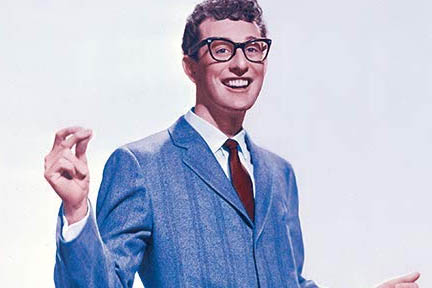
| Buddy Holly | |
|---|---|

Buddy Holly in 1957
|
|
| Background information | |
| Birth name | Charles Hardin Holley |
| Born | September 7, 1936 Lubbock, Texas, United States |
| Died | February 3, 1959 (aged 22) near Clear Lake, Iowa, United States |
| Genres |
|
| Occupation(s) | Singer-songwriter, musician, producer |
| Instruments | Vocals, guitar |
| Years active | 1955–1959 |
| Labels | Decca, Brunswick, Coral |
| Associated acts | Buddy and Bob, The Crickets, the The Picks |
| Notable instruments | |
| Fender Stratocaster, Gibson J-45 | |
Charles Hardin Holley (September 7, 1936 – February 3, 1959), known as Buddy Holly, was an American musician and singer-songwriter who was a central figure of mid-1950s rock and roll. Holly was born in Lubbock, Texas, to a musical family during the Great Depression; he learned to play guitar and to sing alongside his siblings. His style was influenced by gospel music, country music and rhythm and blues acts, and he performed in Lubbock with his friends from high school. He made his first appearance on local television in 1952, and the following year he formed the group "Buddy and Bob" with his friend Bob Montgomery. In 1955, after opening for Elvis Presley, Holly decided to pursue a career in music. He opened for Presley three times that year; his band's style shifted from country and western to entirely rock and roll. In October that year, when he opened for Bill Haley & His Comets, Holly was spotted by Nashville scout Eddie Crandall, who helped him get a contract with Decca Records.
Holly's recording sessions at Decca were produced by Owen Bradley. Unhappy with Bradley's control in the studio and with the sound he achieved there, Holly went to producer Norman Petty in Clovis, New Mexico, and recorded a demo of "That'll Be the Day", among other songs. Petty became the band's manager and sent the demo to Brunswick Records, which released it as a single credited to "The Crickets", which became the name of Holly's band. In September 1957, as the band toured, "That'll Be the Day" topped the US "Best Sellers in Stores" chart and the UK Singles Chart. Its success was followed in October by another major hit, "Peggy Sue".
The album Chirping Crickets, released in November 1957, reached number five on the UK Albums Chart. Holly made his second appearance on The Ed Sullivan Show in January 1958 and soon after, toured Australia and then the UK. In early 1959, Holly assembled a new band, consisting of future country music star Waylon Jennings (bass), famed session musician Tommy Allsup (guitar), and Carl Bunch (drums), and embarked on a tour of the midwestern U.S. After a show in Clear Lake, Iowa, Holly chartered an airplane to travel to his next show, in Moorhead, Minnesota. Soon after takeoff, the plane crashed, killing Holly, Ritchie Valens, the Big Bopper, and the pilot, in a tragedy later elegized by Don McLean as "The Day the Music Died".
During his short career, Holly wrote, recorded, and produced his own material. He is often regarded as the artist who defined the traditional rock-and-roll lineup of two guitars, bass, and drums. Holly was a major influence on later popular music artists, including the Beatles, the Rolling Stones, Eric Clapton, and Elton John. He was among the first artists inducted into the Rock and Roll Hall of Fame, in 1986. Rolling Stone magazine ranked him number 13 in its list of "100 Greatest Artists". (wikipedia)

